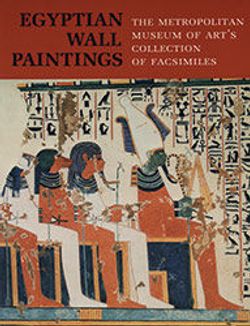Animals Seated under a Chair, Tomb of Anen
New Kingdom
This facsimile copies a detail from a larger scene painted in the transverse hall of Theban tomb no. 120. This rock-cut tomb was made for the “Second Prophet of Amun” Anen, the brother of Tiye, principal queen of King Amenhotep III. Most of the chapel’s wall decoration had been destroyed, and only fragments were found by Norman de Garis Davies, the Egyptologist who painted this facsimile. However, parts of a large scene depicting Queen Tiye and her husband seated in a pavilion (see 33.8.8) had been preserved. This facsimile records the lower left part.
Under Queen Tiye’s armchair, a vervet monkey jumps over a goose and a cat shown in a tight embrace. Animals depicted beneath a chair are a common feature in tombs during the New Kingdom. We often find cats and monkeys under the chairs of female figures, usually the tomb owner’s wife. Both were treated as family pets, and often were given names.
However, the association between the three animals here, as well as their posture and their placement under the queen’s chair, suggest that they are more than an anecdotal rendering of beloved pets.
In ancient Egypt, the vervet monkey often symbolized fertility and sexuality. The goose and the cat embracing may refer to the gods Amun and Re, whose sacred animals they were, but these animals were also connected to maternity (goose) and eroticism (cat). It would be tempting to see them as allusions to Queen Tiye’s role as the wife of the king, who was the earthly embodiment of the sun god

